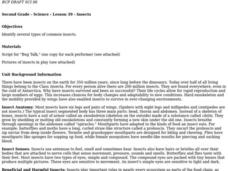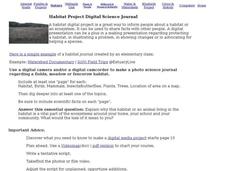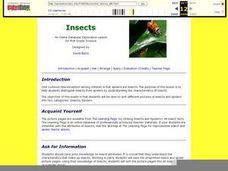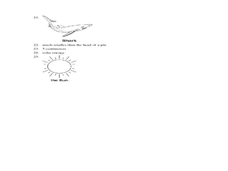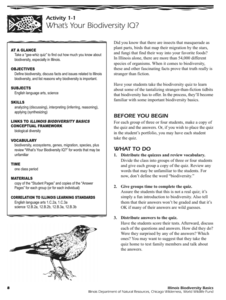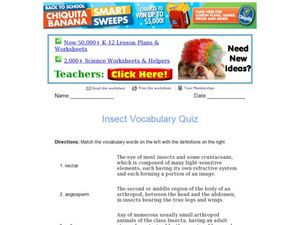Curated OER
Insect Anatomy
In this science worksheet, students learn the 3 parts of an insect's body by examining a labeled diagram. Students also read other facts about insect anatomy. Students practice printing the names of the 3 parts of an insect's body on the...
Curated OER
Insects
Second graders brainstorm and identify several types of common insects. They play bug bingo, building bugs and an insect tree, observing real insects in the classroom and examining some of the things insects make.
Curated OER
Tic Tac Plant Parts
This plant biology PowerPoint introduces plant parts and their functions. This PowerPoint allows students to identify each plant part on a diagram, along with its' function. The slides contain a clear explanation of how each plant part...
Curated OER
Habitat Project Digital Science Journal
In this habitat project digital science journal worksheet, students use a digital camera or camcorder to create a science journal about a habitat they have studied. This page includes links to helpful web resources for planning and...
Curated OER
Science: How to Identify Insects
First graders discover how to distinguish spiders from insects by understanding the characteristics of each. They sort online picture pages into the two groups and examine the insects for common attributes. Students complete a worksheet...
Curated OER
Insects Crossword
In this insects worksheet, students read 10 clues pertaining to insects. Students choose the words from the word box that match the clues and fit them into the crossword puzzle.
Curated OER
Science Review for Grade 3 (3.5)
In this science review for grade 3 (3.5) worksheet, 3rd graders answer 25 multiple choice questions in standardized test format about fossils, simple machines and heat transfer.
Curated OER
Bug Snack
Students create an insect out of food. In this insect characteristics lesson, students review the 3 body parts of an insect and use various foods to create a sample insect. Students learn a song about insect body parts.
Curated OER
Bug Me While I'm Eating!
Young scholars explore nutritional value of insects as food, and compare the nutritional value of insects with that of their favorite foods by completing a table.
Curated OER
Feelin' Buggy
Students discuss five senses, compare and contrast human and insect senses, use adjectives to describe things they touch, smell, and see, and write stories in first person describing what it would be like to be size of insect.
Curated OER
Spider Watching
Spiders are creepy, crawly - and interesting! Young entomologists learn about parts of a spider's body, their habitats, ways spiders catch their prey, and what they most like to eat. Some excellent art activities are included in the plan...
Houghton Mifflin Harcourt
Zombie Ants
One of the creepiest and coolest natural occurrences is a great forum for data analysis and discussion! Explore the phenomenon of zombie ants, or ants infected with the Cordyceps fungus, with a series of activities and experiments. Kids...
Curated OER
Insect or Spider?
Students compare and contrast the difference between insects and spiders. After a brief class discussion, students complete an activity matching the body parts of an insect and the body parts of a spider. Worksheet with answer key is...
Curated OER
Those Busy, Buzz'n Worker Bees
Learners research information on worker bees. In this insect lesson, students review the body parts of insects and how bees find flowers. They discuss compound and simple eyes and the life cycle of a worker bee.
Teacher Web
Plant Reproduction—Structure of a Flower
What happened to the plant in math class? It grew square roots. Here, a set of 11 worksheets provide a review of plant reproduction. It includes the structure of a flower and each part's function, pollination, fertilization, seed...
Illinois Department of Natural Resources
Section One: What is Biodiversity?
Four intriguing and scientific activities invite learners to explore the natural resources of their town. The activities cover concepts such as genetic traits, organizing species in a taxonomy, the differences between different species...
National Park Service
Biodiversity—Bee Week
If you want scholars to fall in love with bees, this is the unit for you! Celebrate bees with a full week of material—designed for the Next Generation Science Standards—that addresses the importance of pollination and fertilization....
Curated OER
Insects
In this insects and bugs worksheet, students choose the multiple choice answer that answers 15 questions or facts about insects and bugs correctly.
Curated OER
Create Your Own Insect
In insect worksheet, students read the facts about insects. Students then use the insects and create their own insect including all the body parts listed.
Michigan State University
Bug Lyphe!
Introduce ecology classes to biodiversity and interdependence in ecosystems with a PowerPoint presentation. Then, they get up-close and personal with the invertebrate world by collecting insects, classifying them, and graphing their...
Terminix
The Pollinator
What do bees and children have in common? They both love their sweets. Decorate a flower pot or bucket to look like a brightly colored flower and fill it with wrapped candy and cheese puffs. Have learners reach into grab the candy,...
Curated OER
Plant Life Cycle: Quiz Game
Play the game, Who Wants to be a Millionaire? to review plant parts, life cycle, and pollination. There are 10 questions that get kids thinking about seeds, seed dispersal, pollination, and plant parts. This game is has audio and looks...
Curated OER
A Bugs Life: Diary of an Insect's Metamorphosis
Students play games to learn about the life stages and metamorphosis of different insects. In this insects lesson plan, students discuss the life of insects, and then play matching, vocabulary, and memory games.
Curated OER
Insect Vocabulary Quiz
In this insect vocabulary worksheet, students draw lines to match ten words pertaining to insect anatomy to their definitions.



